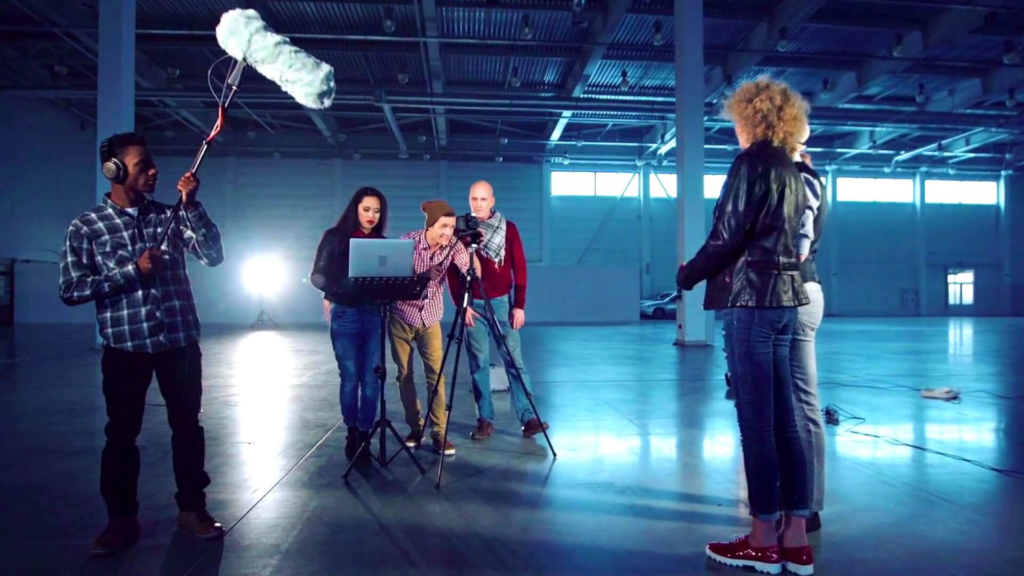Production Assistant (1 years diploma)
Production Assistant click here
Brief Job Description: Individuals play an assistive/ supportive role across the
production department and undertake with wide a range of activities. This may
include logistics, co-ordination, preparing documents and checking that
equipment and materials are in place. All the activities outlined below must be
read in context of an “assistive” rather than “leading” role.
Personal Attributes: This job requires the individual to understand production
techniques and the implications of various tasks on time, resources and budget.
The individual must have some background in film making or content production.
The individual must understand logistics and facilities required during filming.
The individual must be able and willing to help on any task that facilitate
production/ filming. The person should have good communication skills, be
capable of understanding instructions and be able to work well as part of a team.
Description
Budget Budget is an estimate of the total cost of production that may include a
break-up of cost components
Continuity Continuity represents the seamless transition from one shot to another
Copyright Laws A legal framework linked to intellectual property and the rights given to
creators of original products/ concepts

Financer An entity (individual or organization) that provides financing for a project
Labour Laws Legal norms governing the relationship between workers, employers,
trade unions and the government
Post-production Post-production is the final finishing phase of the production, where the
raw footage is edited, special effects are added, music and sound are
integrated, colour correction is done etc.
Props A property, commonly shortened to prop (plural: props), is an object used
on stage or on screen by actors during a performance or screen
production. In practical terms, a prop is considered to be anything
movable or portable on a stage or a set.
Screenplay Screenplay is the script coupled with key characteristics of the scene and
directions for acting
Script Script is a structured narrative of a story
Set The background/ scenery visible through the camera (for video
production) or directly to the spectator (for theatrical production)
Set Etiquette A set of guidelines that dictate how cast and crew should behave on set
and interact with each other
Target Audience Group of people at whom content/ adverting is aimed. A target audience
is typically defined by age, gender, economic classification, geography and
any other relevant parameters
Timelines Timelines is a listing of dates by which the production milestones/stages
need to be completed
Sector Sector is a conglomeration of different business operations having similar
businesses and interests. It may also be defined as a distinct subset of the
economy whose components share similar characteristics and interests.
Sub-sector Sub-sector is derived from a further breakdown based on the
characteristics and interests of its components.
Vertical Vertical may exist within a sub-sector representing different domain areas
or the client industries served by the industry
Occupation Occupation is a set of job roles, which perform similar/related set of functions
in an industry
Function Function is an activity necessary for achieving the key purpose of the sector,
occupation, or area of work, which can be carried out by a person or a group of
persons. Functions are identified through functional analysis and form the basis
of OS.
Sub-functions Sub-functions are sub-activities essential to fulfill the achieving the objectives of
the function.
Job role Job role defines a unique set of functions that together form a unique
employment opportunity in an organization.
Occupational Standards

(OS)
OS specify the standards of performance an individual must achieve when
carrying out a function in the workplace, together with the knowledge and
understanding they need to meet that standard consistently. Occupational
Standards are applicable both in the Indian and global contexts.
Performance Criteria Performance Criteria are statements that together specify the standard of
performance required when carrying out a task
National Occupational
Standards (NOS)
NOS are Occupational Standards which apply uniquely in the Indian context.
Qualifications Pack
Code
Qualifications Pack Code is a unique reference code that identifies a
qualifications pack.
Qualifications Pack(QP) Qualifications Pack comprises the set of OS, together with the educational,
training and other criteria required to perform a job role. A Qualifications Pack
is assigned a unique qualification pack code.
Unit Code Unit Code is a unique identifier for an Occupational Standard, which is denoted
by an ‘N’.
Unit Title Unit Title gives a clear overall statement about what the incumbent should be
able to do.
Description Description gives a short summary of the unit content. This would be helpful to
anyone searching on a database to verify that this is the appropriate OS they are
looking for.
Scope Scope is the set of statements specifying the range of variables that an individual
may have to deal with in carrying out the function which have a critical impact
on the quality of performance required.
Knowledge and
Understanding
Knowledge and Understanding are statements which together specify the
technical, generic, professional and organizational specific knowledge that an
individual needs in order to perform to the required standard.
Organizational Context Organizational Context includes the way the organization is structured and how
it operates, including the extent of operative knowledge managers have of their
relevant areas of responsibility.

Technical Knowledge Technical Knowledge is the specific knowledge needed to accomplish specific
designated responsibilities.
Core Skills/Generic
Skills
Core Skills or Generic Skills are a group of skills that are key to learning and
working in today’s world. These skills are typically needed in any work
environment. In the context of the OS, these include communication
related skills that are applicable to most job roles.
Description
NOS National Occupational Standard(s)
QP Qualifications Pack
NVEQF National Vocational Education Qualifications Framework
NVQF National Vocational Qualifications Framework
NSQF National Skills Qualification Framework
Coordinate production activities
Description This OS unit is about coordinating production activities and resources for filming,
monitoring progress and highlighting variances to the schedule and budget
Scope This unit/task covers:
Coordinating production activities
Performance Criteria (PC) w.r.t. the Scope
Element Performance Criteria
Coordinating
production activities
To be competent, the user/individual on the job must be able to:
PC1. break-down the production schedule into a daily task list and manage, or
support in managing, these day to day activities during filming
PC2. lead, or support, the production unit toward successful completion of their
tasks
PC3. track progress of filming against the production schedule and budget, in line
with one’s role
PC4. anticipate potential delays/ budget overruns, escalate these to relevant
departments/superiors and identify ways to minimize them
Knowledge and Understanding (K)
A. Organizational
Context
(Knowledge of the
company /
organization and
its processes)
The user/individual on the job needs to know and understand:
KA1. the vision and motivations of the creative team (Scriptwriter, Director,
Production Designer among others)
KA2. production limitations including details of shooting locations and any key
constraints on budget, resources and time availability
KA3. the role and contribution of key departments during filming,
interdependencies and reporting structures
B. Technical
Knowledge
The user/individual on the job needs to know and understand:
KB1. how to break down the production schedule into a daily task list with details
of personnel, equipment and materials required on set, as necessary in the
context of the role
KB2. available options for transporting equipment and material securely to the
location and ensuring safe storage

KB3. how to coordinate, or support in coordinating, logistics for the cast and crew
including travel, ground transport, accommodation, facilities on set including
rest areas and catering
KB4. how to coordinate, or support in coordinating, logistics for child artistes and
their accompanying adults including travel, ground transport,
accommodation, facilities on set including rest areas and catering
KB5. how to coordinate, or support in coordinating, logistics for any animals being
used for filming including the number of wranglers/ handlers required, their
travel, ground transport, accommodation, facilities on set including rest areas
and catering and any permissions required from local, state or central
authorities for principal photography
KB6. how to confirm if all approvals and permissions (from local, state or central
authorities) required for filming have been taken, and the points of contact in
case of any last-minute issues
KB7. how to confirm, or support in confirming, if duties and any other applicable
charges on equipment and material have been paid to the revenue authorities
KB8. how to confirm, or support in confirming, if all required insurance policies
have been purchased (e.g. fire insurance, theft insurance and insurance for
unintentional damage to equipment)
KB9. how to liaise with the Location Manager/ Floor Manager/ Unit Production
Manager to ensure that all elements required for filming are in place, as
necessary in the context of the role
KB10. in case of damage to or non-availability of resources, identify alternatives/
substitutes that can be used without compromising on the production
objectives
KB11. prepare a daily progress report at the end of each day and track completion
against the production schedule and budget, as necessary in the context of the
role
KB12. anticipate potential delays/ overruns and highlight them to the respective
departments
KB13. check against the production schedule that all tasks have been delivered, , as
necessary in the context of the role
KB14. observe inventory vs. delivery trends (in fields such as animation and gaming),
or planned vs. actual – and make required changes to make the process of
scheduling and delivery more effective
KB15. act as a central point of contact for all teams and resolve any interdependency
issues that could affect smooth functioning of the unit
KB16. how to ensure that all production activities minimize risks, including those to
the individual’s own health and safety and of the production cast and crew
Skills (S)
A. Core Skills/
Generic Skills
Writing Skills
The user/ individual on the job needs to know and understand how to:
SA1. take notes and mark-up production schedules and budgets to identify
potential areas of concern
SA2. prepare daily call sheets, task lists and other types of check lists, in line with
one’s role

SA3. prepare a daily progress report (on paper or using a computer) and highlight
variance against the production schedule and budget, in line with one’s role
Reading Skills
The user/individual on the job needs to know and understand how to:
SA4. interpret the script/ creative brief/ production concept/ schedule/ budget or
any other type of written material, in line with one’s role
SA5. correctly read vendor and supplier bills to ensure that expenses are aligned to
the production budget
Oral Communication (Listening and Speaking skills)
The user/individual on the job needs to know and understand how to:
SA6. understand the creative vision of the Director/ Script writer and Producer, as
appropriate
SA7. understand the brief from the financer and any constraints/ limitations that
affect the production (e.g. time, people, materials, location, budget), as
appropriate
SA8. communicate effectively with some/entire production unit, propose
alternatives and agree on key decisions
A. Professional Skills Decision Making
The user/individual on the job needs to know and understand how to:
SB1. make relevant decisions related to the area of work e.g. sequencing of
activities, choice of cast and crew, production techniques, choice of location,
vendor selection etc.
Plan and Organize
The user/individual on the job needs to know and understand:
SB2. how to prepare a work schedule/ sequence of activities to help the entire
production unit plan their work on a daily basis, if appropriate
SB3. how to build a contingency plan based on knowledge of typical areas of
delays/ overruns and production risks
Problem Solving
The user/individual on the job needs to know and understand how to:
SB4. identify any problems with successful execution of the task and resolve them
in consultation with the relevant members of the production unit
Analytical Thinking
The user/individual on the job needs to know and understand:
SB5. how to assess the impact of selecting production techniques, cast, crew,
vendors and suppliers on the time, location and budget of the production, if
appropriate
Customer Centricity
The user/individual on the job needs to know and understand:
SB6. communicate and coordinate properly about project requirements there by
facilitating team development
Critical Thinking
The user/individual on the job needs to know and understand:
SB7. appraise the quality of the production activities to ensure they are in line
with the expected quality standards and suggest areas of improvement
Manage content archival
Description This OS unit is about ensuring that content is stored safely after production and is
archived/captured in a manner that allows for easy retrieval.
Scope This unit/task covers:
Archiving raw footage and final products
Note:
On large projects, the post production department (and specifically the post
production supervisor) is also responsible for taking and maintaining back-ups of
footage.
Performance Criteria (PC) w.r.t. the Scope
Element Performance Criteria
Archiving raw footage
and final products
To be competent, the user/individual on the job must be able to:
PC1. identify content that needs to be archived (this usually includes the finished
product and in certain cases raw footage and older versions)
PC2. convert content (or supervise conversion of content) into the required format
and according to accepted file naming conventions
PC3. ensure interim and final outputs meet quality standards
PC4. tag and store archived content in a manner that allows for easy access and
retrieval
Knowledge and Understanding (K)
A. Organizational
Context
(Knowledge of the
company /
organization and
its processes)
The user/individual on the job needs to know and understand:
KA1. organizational processes for archival and record management, including any
interaction with the post production supervisor and other members of the
post production department
KA2. any constraints on archival including the budget, resources and time
availability
B. Technical
Knowledge
The user/individual on the job needs to know and understand:
KB1. the types of content (finished product, older versions, raw footage) that need
to be archived
KB2. how to estimate the time, budget and resource requirements for archival
KB3. how to convert analog/ tape-based content to digital file formats
KB4. how to select the appropriate resolution, aspect ratio and pixel ratio based
on the archiving requirements
KB5. how to save interim and final deliverables in the required format using
appropriate file naming conventions
KB6. how to test archived footage to ensure quality standards are met
KB7. how to label and mark archived content to ensure easy access and retrieval
KB8. appropriate storage methods (including fireproof storage) to ensure that
content is stored securely
KB9. applicable health and safety guidelines
Writing Skills
The user/ individual on the job needs to know and understand how to:
SA1. label and mark archived content
SA2. prepare schedules and effort estimates for archival
Reading Skills
The user/individual on the job needs to know and understand how to:
SA3. correctly identify footage/ content based on information provided
Oral Communication (Listening and Speaking skills)
The user/individual on the job needs to know and understand how to:
SA4. understand the archival requirements from the relevant heads of department
SA5. communicate effectively with production unit, propose alternatives and
agree on key decisions
B. Professional Skills Decision Making
The user/individual on the job needs to know and understand how to:
SB1. make relevant decisions related to the area of work e.g. choice of archival
technique, file formats, storage methods etc.
Plan and Organize
The user/individual on the job needs to know and understand:
SB2. plan own work according to the requirements and agreed timelines
SB3. manage within the agreed budget and minimize overruns
Problem Solving
The user/individual on the job needs to know and understand how to:
SB4. identify any problems with successful execution of the task and resolve them
in consultation with the relevant members of the production unit
SB5. identify any technical constraints to successful archival and resolve them in
consultation with the relevant members of the production unit
Critical Thinking
The user/individual on the job needs to know and understand how to:
SB6. have an appreciation for accuracy and pay close attention to details while
choosing file formats and different storage methods .
Analytical Thinking
The user/individual on the job needs to know and understand how to:
SB7. envision the impact of the storing the contents in a particular manner
Customer Centricity
The user/individual on the job needs to know and understand how to:
SB8. check that assets stored meets basic technical and creative requirements of a
project.









